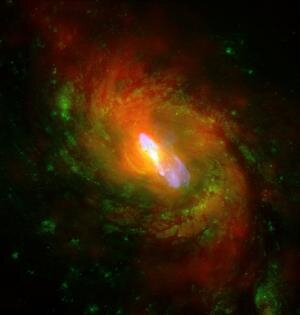Supermassive Black Holes Strip Massive Galaxies of Star-Forming Gases
Black holes have long been beloved of science fiction writers for their destructive capabilities and peculiar ability to warp space time.
Now a study led by researchers from The University of Nottingham reveals the awesome power of supermassive black holes - the ability to strip massive galaxies of the cool gases required to form new stars, leaving ageing red giants to splutter out of existence with no stars to replace them.
The study, led by Asa Bluck in the School of Physics and Astronomy, used images of unprecedented depth and resolution from the Hubble Space Telescope and the Chandra X-Ray Observatory to detect black holes in distant galaxies. Researchers looked for galaxies emitting high levels of radiation and x-rays -- a classic signature of black holes devouring gas and dust through accretion, or attracting matter gravitationally.
As this matter swirls around the event horizon of a black hole it heats up and radiates energy - as an accretion disc. The study, which was funded by the Science and Technology Facilities Council and NASA and was a collaboration between researchers at The University of Nottingham and Imperial College London, gleaned some startling results.
In supermassive black holes this radiation can reach huge proportions, emitting X-ray radiation in far greater quantities then is emitted by the rest of the objects in the galaxy combined - meaning that the black hole 'shines' far brighter than the entire galaxy it lies at the heart of. In fact, the amount of energy released is sufficient to strip the galaxy of gas at least 25 times over.
Results have also shown that the vast majority of the X-ray radiation present in the universe is produced in these accretion discs surrounding supermassive black holes, with a small proportion produced by all other objects, including galaxies and neutron stars.

"Composite image of NGC 1068, one of the nearest and brightest galaxies containing a rapidly growing supermassive black hole. (Credit: X-ray (NASA/CXC/MIT/C.Canizares, D.Evans et al), Optical (NASA/STScI), Radio (NSF/NRAO/VLA))"
Source: University of Nottingham
|